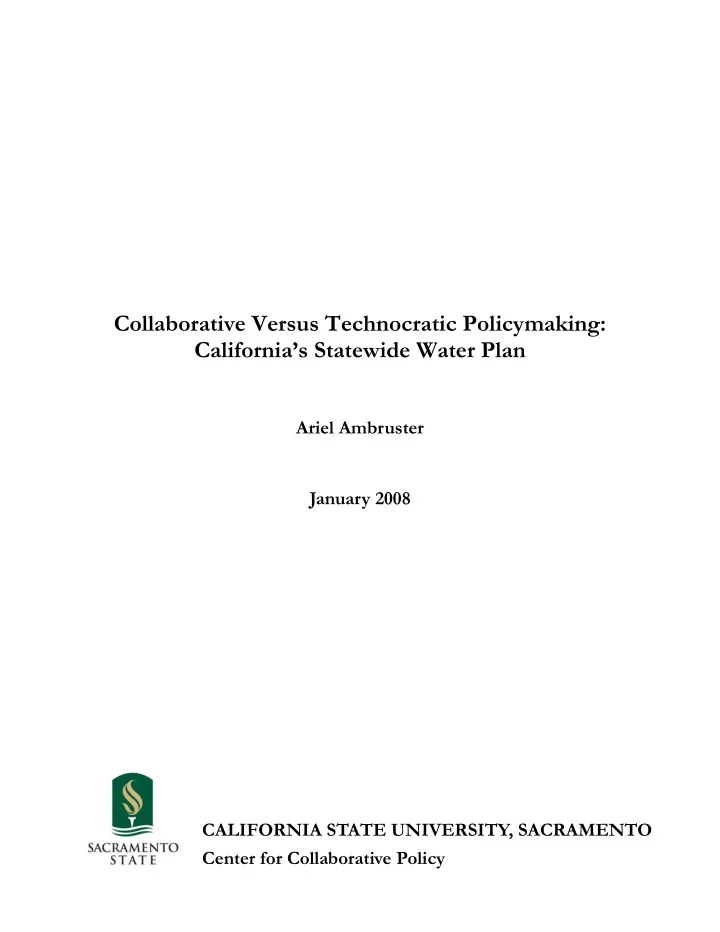

Collaborative Versus Technocratic Policymaking: California’s Statewide Water Plan Ariel Ambruster January 2008 CALIFORNIA STATE UNIVERSITY, SACRAMENTO Center for Collaborative Policy
Center for Collaborative Policy California State University, Sacramento 815 S Street, 1 st floor Sacramento, CA 95811 916.445.2079 http://www.csus.edu/ccp/ This report may be freely reproduced and distributed for non-commercial use provided it is not modified and provided that acknowledgment is given to the author and the Center for Collaborative Policy.
Contents Foreword............................................................................................................................. 2 About the Center for Collaborative Policy ......................................................................... 4 Executive Summary............................................................................................................ 5 Acknowledgments............................................................................................................... 6 Introduction......................................................................................................................... 7 Conceptual Context: Collaboration in Planning ................................................................. 8 Methods............................................................................................................................. 11 Interviews.................................................................................................................. 12 Sample Selection....................................................................................................... 12 Meeting Observation................................................................................................. 14 Written Documents................................................................................................... 14 Evaluation Criteria.................................................................................................... 15 Methodological Limitations.............................................................................................. 16 Unequal Timing and Scope of Observations ............................................................ 16 Different Political Contexts ...................................................................................... 16 Different Climates for Collaboration........................................................................ 17 Different Personalities .............................................................................................. 17 Different Goals.......................................................................................................... 17 History and Maturation............................................................................................. 17 Water Resources in California.......................................................................................... 18 The California State Water Plan ....................................................................................... 19 Structural Differences between the 1998 and 2005 Planning Processes .......................... 20 Account of the 1998 Planning Process ............................................................................. 24 Account of the 2005 Planning Process ............................................................................. 26 Findings: Comparing Outcomes of the 1998 and 2005 Processes.................................... 31 Products of the Processes: Comparing the Updates.................................................. 31 Update Content ................................................................................................. 31 Satisfaction of Codified Goals and Objectives................................................. 32 Plan Quality and Innovation ............................................................................. 33 Intangible Outcomes................................................................................................. 36 Social and Political Capital............................................................................... 36 Development of Agreed-on Information and Shared Understandings ............. 42 End to Stalemate ............................................................................................... 48 Institutional Change.......................................................................................... 48 Learning and Change beyond Original Stakeholders ....................................... 50 Conclusion ........................................................................................................................ 51 The Plans as Outcomes............................................................................................. 51 Social, Cultural, Intellectual and Institutional Outcomes......................................... 52 The State Water Plan Update and the Literature on Collaboration .......................... 54 References......................................................................................................................... 56 Appendix 1: Table of Contents, California Water Plan Update 1998 ............................. 59 Appendix 2: Table of Contents, California Water Plan Update 2005 ............................. 72 1
Foreword In 2001, the California Department of Water Resources embarked on one of the most elaborate public involvement processes in state history. Over the course of five years and 200 meetings, a 65-member Stakeholder Advisory Committee and a 350- member Extended Review Forum worked with agency staff to produce a new water plan for California. The process consumed some 23,000 person-hours in face-to-face discussions alone. Although the state had been updating its water plan approximately every five years since 1957, the 2005 process produced a dramatically different type of document. For one thing, the 2005 Update is conceptually more accurate, complex, nuanced, and comprehensive. The policy recommendations described in its strategic plan address a broader range of issues—including climate change and environmental justice— yet they engendered somewhat less political controversy than the policies identified in the 1998 Update. Moreover, there is evidence that the collaborative process used in 2001- 2005 catalyzed improvements in the relationships among California's historically warring water stakeholders, and also sparked the beginnings of positive cultural changes within certain quarters of DWR. This research report authored by Ariel Ambruster catalogues the outcomes of the 2005 Water Plan Update process and those of its predecessor, the 1998 Update. As the title of the report implies, one of its most unique contributions is in comparing a highly collaborative process to a more traditional, top-down planning process. For a number of reasons, designing comparative studies is challenging, and only a handful of such studies exist in the academic literatures on planning and public administration. Thus, social scientists to date have learned remarkably little about the comparative advantages and disadvantages of collaborative approaches to governance. Although we have made significant strides in uncovering the keys to successful collaboration, we still know very little about what collaboration is capable of achieving in comparison to alternative approaches. Put another way, we know much about how to collaborate, but less about when to collaborate. Theories from disparate disciplines maintain that the outcomes of collaborative governance are superior in a variety of ways. However, other legal and theoretical arguments challenge these claims. To test the dueling theories, we need empirical studies that compare at least one collaborative process and one alternative, and that use the same criteria to evaluate each process. The report before you represents one of the first studies of this kind. Given the great variety of collaborative strategies, we will never achieve blanket conclusions about collaboration being “better” or “worse” across the board. On the other hand, we ought to be able to identify the types of outcomes that collaboration is comparatively effective at achieving and the types of situations where collaboration is likely to outperform the alternatives. This report makes much needed progress in addressing such questions. The author, Ariel Ambruster, conducted the study and documented its finding in a 2007 Professional Report for the master's degree program in the Department of City and Regional Planning at the University of California, Berkeley. The Center for Collaborative Policy at California State University, Sacramento is proud to call attention to the study by publishing it as one in a series of occasional research reports. 2
Recommend
More recommend